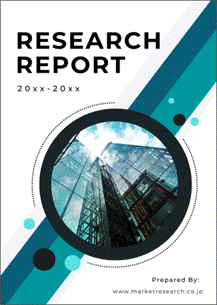 | • レポートコード:MRC2303B046 • 出版社/出版日:Mordor Intelligence / 2023年1月 • レポート形態:英文、PDF、150ページ • 納品方法:Eメール(受注後2-3営業日) • 産業分類:材料 |
| Single User | ¥703,000 (USD4,750) | ▷ お問い合わせ |
| Corporate License | ¥1,295,000 (USD8,750) | ▷ お問い合わせ |
• お支払方法:銀行振込(納品後、ご請求書送付)
レポート概要
| Mordor Intelligence社の本市場調査レポートでは、世界のバイオベースポリウレタン市場規模が、予測期間中(2022年~2027年)に年平均15%で成長すると展望しています。本書は、バイオベースポリウレタンの世界市場について総合的に分析し、イントロダクション、調査手法、エグゼクティブサマリー、市場動向、用途別(発泡剤、コーティング剤、接着剤・シーラント剤、その他(ポリウレタンバインダー、ポリウレタンディスパージョン))分析、産業別(輸送、フットウェア・繊維、建設、包装、その他)分析、地域別(中国、インド、日本、韓国、アメリカ、カナダ、メキシコ、ドイツ、イギリス、イタリア、フランス、スペイン、ブラジル、サウジアラビア、南アフリカ)分析、競争状況、市場機会・将来の動向などの項目を整理しています。さらに、参入企業として、Arkema SA、BASF SE、Covestro AG、Huntsman International LLC、Miracll Chemicals Co. Ltd、Mitsui Chemicals Inc.、Stahl Holdings BV、Toray Industries Inc.、Teijin Limited、The Lubrizol Corporation、Woodbridgeなどの情報を含んでいます。 ・イントロダクション ・調査手法 ・エグゼクティブサマリー ・市場動向 ・世界のバイオベースポリウレタン市場規模:用途別 - 発泡剤における市場規模 - コーティング剤における市場規模 - 接着剤・シーラント剤における市場規模 - その他(ポリウレタンバインダー、ポリウレタンディスパージョン)における市場規模 ・世界のバイオベースポリウレタン市場規模:産業別 - 輸送における市場規模 - フットウェア・繊維における市場規模 - 建設における市場規模 - 包装における市場規模 - その他における市場規模 ・世界のバイオベースポリウレタン市場規模:地域別 - アジア太平洋のバイオベースポリウレタン市場規模 中国のバイオベースポリウレタン市場規模 インドのバイオベースポリウレタン市場規模 日本のバイオベースポリウレタン市場規模 … - 北米のバイオベースポリウレタン市場規模 アメリカのバイオベースポリウレタン市場規模 カナダのバイオベースポリウレタン市場規模 メキシコのバイオベースポリウレタン市場規模 … - ヨーロッパのバイオベースポリウレタン市場規模 ドイツのバイオベースポリウレタン市場規模 イギリスのバイオベースポリウレタン市場規模 イタリアのバイオベースポリウレタン市場規模 … - その他地域のバイオベースポリウレタン市場規模 ・競争状況 ・市場機会・将来の動向 |
The bio-based polyurethane market is projected to register a CAGR of greater than 15% during the forecast period (2022-2027).
The market was negatively affected by COVID-19 in 2021. The construction industry was significantly impacted during the pandemic, which affected the demand in the market studied. However, the market is excepted to retain its growth trajectory in the coming years.
Key Highlights
- Over the mid-term, the key factors driving the market studied are the increasing demand from the construction industry in developing countries and increasing demand from electronic appliances manufacturing.
- On the flip side, the high cost of bio-based materials is expected to hinder the growth of the market studied.
- Industrial growth in Middle-East is expected to act as an opportunity during the forecast period.
Bio-based Polyurethane Market Trends
Increasing Demand from the Transportation Industry
- Bio-based polyurethane finds its key applications in the transportation industry, including the automotive, railway, and aerospace industries. Moreover, the automotive industry consumes bio-based PU foams, coatings, adhesives, and sealants. Specifically, bio-based PU foams are used in seating systems (headrests, headliners, armrests, seat cushioning, and others) and interior parts.
- According to OCIA, global automotive production reached 80.14 million units in 2021. The production capacity increased by 3% compared to 2020. Thus, growth in automotive vehicle production is likely to boost the market for bio-based polyurethane materials.
- Asia-Pacific, the largest automotive production region, also witnessed a growth rate of 6% in 2021. The production increased from 44.27 million in 2020 to 46.73 million in 2021, respectively. Similarly, South America witnessed 18% and 16% growth rates, respectively, in 2021.
- In the railway industry, bio-based PU has potential applications, as it can replace conventional PU products by a significant amount in the coming years. In railways, bio-based foams can be used in seat cushioning and for thermal insulation applications. Furthermore, in the aerospace industry, bio-based PU foams and coatings can substitute conventional PU materials.
- Therefore, the demand in the transportation industry is expected to increase the demand for bio-based polyurethane during the forecast period.
Asia-Pacific to Dominate the Market
- Asia-Pacific is the largest producer of bio-based polyurethane, with a high abundance of synthetic diisocyanates and a large number of bio-based polyurethane in the region.
- China is in the midst of a construction mega-boom. The country has the largest buildings market in the region and in the world, making up 20% of all construction investments globally. The Chinese government is estimated to have an annual limit for new infrastructure bonds worth CNY 3.85 trillion in 2022, up from CNY 3.65 trillion in 2021.
- According to OICA, around 4.39 million vehicles were produced in China in 2021, compared to 3.38 million vehicles produced in 2020, witnessing a growth rate of about 30%. This scenario is expected to boost the bio-based polyurethane market in the country.
- Similarly, in India, the electronics market witnessed a growth in demand, with market size increasing at a rapid growth rate. India’s electronic goods exports fetched USD 11.11 billion in 2020-21. The growing electronics and appliances markets in India and China may push the market growth further in Asia-Pacific.
- The aforementioned factors are likely to increase the demand for bio-based polyurethane during the forecast period.
Bio-based Polyurethane Market Competitor Analysis
The bio-based polyurethane market is consolidated in nature. The major manufacturers in the market studied include BASF SE, Covestro AG, Huntsman International LLC, Mitsui Chemicals Inc., and The Lubrizol Corporation.
Additional Benefits:
- The market estimate (ME) sheet in Excel format
- 3 months of analyst support
1 INTRODUCTION
1.1 Study Assumptions
1.2 Scope of the Study
2 RESEARCH METHODOLOGY
3 EXECUTIVE SUMMARY
4 MARKET DYNAMICS
4.1 Drivers
4.1.1 Increasing Demand from the Construction Industry in Developing Countries
4.2 Restraints
4.2.1 High Cost of Bio-based Materials
4.3 Industry Value Chain Analysis
4.4 Porter’s Five Forces Analysis
4.4.1 Bargaining Power of Suppliers
4.4.2 Bargaining Power of Consumers
4.4.3 Threat of New Entrants
4.4.4 Threat of Substitute Products and Services
4.4.5 Degree of Competition
5 MARKET SEGMENTATION
5.1 Application
5.1.1 Foams
5.1.2 Coatings
5.1.3 Adhesive and Sealants
5.1.4 Other Applications (Polyurethane Binders, Polyurethane Dispersions)
5.2 End-user Industry
5.2.1 Transportation
5.2.2 Footwear and Textile
5.2.3 Construction
5.2.4 Packaging
5.2.5 Furniture and Bedding
5.2.6 Electronics
5.2.7 Other End-user Industries (Biomedical, Fertilizer Industry)
5.3 Geography
5.3.1 Asia-Pacific
5.3.1.1 China
5.3.1.2 India
5.3.1.3 Japan
5.3.1.4 South Korea
5.3.1.5 Rest of Asia-Pacific
5.3.2 North America
5.3.2.1 United States
5.3.2.2 Canada
5.3.2.3 Mexico
5.3.3 Europe
5.3.3.1 Germany
5.3.3.2 United Kingdom
5.3.3.3 Italy
5.3.3.4 France
5.3.3.5 Spain
5.3.3.6 Rest of Europe
5.3.4 Rest of the World
5.3.4.1 Brazil
5.3.4.2 Saudi Arabia
5.3.4.3 South Africa
5.3.4.4 Rest of the Countries
6 COMPETITIVE LANDSCAPE
6.1 Mergers and Acquisitions, Joint Ventures, Collaborations, and Agreements
6.2 Market Share(%)**/Ranking Analysis
6.3 Strategies Adopted by Leading Players
6.4 Company Profiles
6.4.1 Arkema SA
6.4.2 BASF SE
6.4.3 Covestro AG
6.4.4 Huntsman International LLC
6.4.5 Miracll Chemicals Co. Ltd
6.4.6 Mitsui Chemicals Inc.
6.4.7 Stahl Holdings BV
6.4.8 Toray Industries Inc.
6.4.9 Teijin Limited
6.4.10 The Lubrizol Corporation
6.4.11 Woodbridge
7 MARKET OPPORTUNITIES AND FUTURE TRENDS
7.1 Industrial Growth in Middle-East
7.2 Developments in Bio-based Building Materials